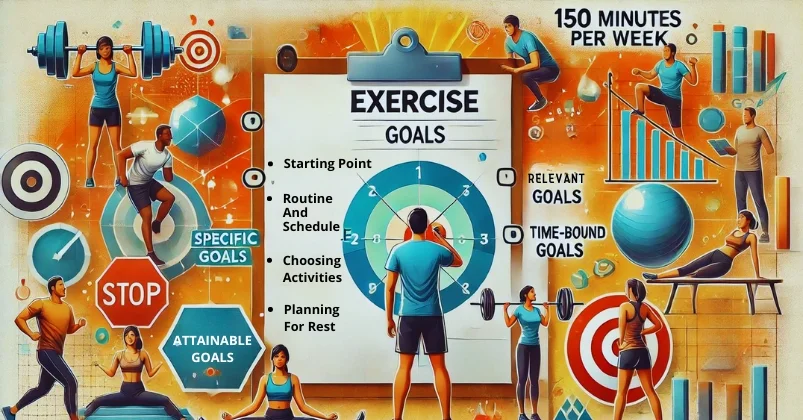Creating Exercise Targets: A Step-by-Step Guide
Creating exercise targets is an essential step towards achieving your fitness goals. Exercise targets are specific, measurable, and achievable goals that help you track your progress and stay motivated. Whether you are a beginner or an experienced athlete, exercise targets can help you improve your fitness levels, prevent injuries, and achieve your desired outcomes.
Understanding exercise targets is crucial before setting them. Exercise targets should be SMART – specific, measurable, achievable, relevant, and time-bound. Setting SMART exercise goals can help you focus on the areas that need improvement, track your progress, and avoid frustration. Additionally, creating an exercise plan and tracking your progress can help you stay accountable and motivated.
Incorporating strength and flexibility training, understanding your fitness level, and seeking the help of a personal trainer or exercise physiologist are some of the ways to ensure that you achieve your exercise targets safely and effectively. In this article, we will discuss the importance of exercise targets, how to set SMART exercise goals, and ways to create an exercise plan that works for you.
Key Takeaways
- Exercise targets are specific, measurable, and achievable goals that help you track your progress and stay motivated.
- Setting SMART exercise goals can help you focus on the areas that need improvement, track your progress, and avoid frustration.
- Incorporating strength and flexibility training, understanding your fitness level, and seeking the help of a personal trainer or exercise physiologist are some of the ways to ensure that you achieve your exercise targets safely and effectively.
Understanding Exercise Targets
Setting exercise targets is an essential part of any fitness program. It helps to keep you motivated, focused, and on track towards achieving your fitness goals. Exercise targets are specific goals that you set for yourself to help you stay on track with your fitness plan. Here are some essential things to know when it comes to understanding exercise targets:
Exercise
Exercise is any physical activity that requires effort and energy expenditure. It is a crucial component of a healthy lifestyle and can help you achieve and maintain good physical and mental health. Exercise can include a wide range of activities, such as running, cycling, swimming, weightlifting, and yoga, among others.
Fitness
Fitness refers to the overall state of your physical health and well-being. It is a combination of your strength, endurance, flexibility, and overall health. Regular exercise is an essential component of achieving and maintaining good fitness.
Physical Activity
Physical activity refers to any movement of the body that requires energy expenditure. It includes exercise, as well as other activities such as walking, gardening, dancing, and playing sports. Engaging in regular physical activity is essential for maintaining good physical and mental health.
Regular Exercise
Regular exercise is a crucial component of a healthy lifestyle. It is recommended that adults engage in at least 150 minutes of moderate-intensity aerobic exercise or 75 minutes of vigorous-intensity aerobic exercise per week. Regular exercise can help to reduce the risk of chronic diseases such as heart disease, diabetes, and obesity.
150 Minutes Per Week
The recommended amount of exercise for adults is at least 150 minutes of moderate-intensity aerobic exercise per week. This can be achieved through activities such as brisk walking, cycling, or swimming. Alternatively, you can engage in 75 minutes of vigorous-intensity aerobic exercise per week, such as running or high-intensity interval training.
Setting exercise targets can help you achieve and maintain good physical and mental health. By understanding the basics of exercise, fitness, physical activity, regular exercise, and 150 minutes per week, you can set realistic and achievable targets that will help you stay on track with your fitness plan.
Setting Smart Exercise Goals
When it comes to achieving your fitness goals, setting targets is crucial. However, it's not enough to simply say, “I want to get fit.” You need to set SMART exercise goals that are specific, measurable, attainable, relevant, and time-bound.
Specific Goals
The first step is to set specific goals. This means defining exactly what you want to achieve. For example, instead of saying “I want to get fit,” a specific goal would be “I want to lose 10 pounds in the next three months.”
Measurable Goals
Once you have set specific goals, you need to make sure they are measurable. This means that you can track your progress and know when you have achieved your goal. For example, instead of saying “I want to get stronger,” a measurable goal would be “I want to increase my bench press by 10 pounds in the next six weeks.”
Attainable Goals
While it's important to set challenging goals, they also need to be attainable. This means that you need to set goals that are realistic and achievable based on your current fitness level and lifestyle. For example, if you've never run before, setting a goal to run a marathon in six months is not attainable. A more attainable goal would be to run a 5k in three months.
Relevant Goals
Your goals also need to be relevant to your overall fitness objectives. For example, if your goal is to improve your cardiovascular fitness, setting a goal to increase your max bench press by 50 pounds is not relevant. A more relevant goal would be to improve your 5k time.
Time-Bound Goals
Finally, your goals need to be time-bound. This means that you need to set a deadline for achieving your goal. For example, instead of saying “I want to lose 10 pounds,” a time-bound goal would be “I want to lose 10 pounds in the next three months.”
By setting SMART exercise goals, you can stay motivated and focused on achieving your fitness objectives. Remember to make your goals specific, measurable, attainable, relevant, and time-bound.
Creating An Exercise Plan
To achieve your fitness goals, it's important to have an exercise plan that is tailored to your needs and abilities. Here are some steps to help you create an effective exercise plan.
Starting Point
Before you start creating your exercise plan, it's important to assess your current fitness level. This will help you determine your starting point and set realistic goals. You can assess your fitness level by measuring your body composition, cardiovascular endurance, muscular strength, and flexibility. Once you have determined your starting point, you can set achievable goals and track your progress.
Routine And Schedule
When creating your exercise plan, it's important to choose a routine that is balanced and sustainable. A balanced routine should include both cardiovascular and strength training exercises. You can choose to do these exercises on separate days or combine them into one workout. It's also important to schedule your workouts at a time that is convenient for you and fits into your daily routine. This will help you stay consistent and make exercise a habit.
Choosing Activities
When choosing activities for your exercise plan, it's important to choose exercises that you enjoy and that are appropriate for your fitness level. You can choose from a variety of activities such as walking, running, cycling, swimming, weightlifting, and yoga. It's also important to vary your workouts to prevent boredom and challenge your body. You can do this by changing the intensity, duration, or type of exercise.
Planning For Rest
Rest and recovery are an important part of any exercise plan. It's important to give your body time to rest and recover between workouts to prevent injury and promote muscle growth. You can plan for rest by scheduling rest days into your workout routine and by practicing active recovery such as stretching, foam rolling, or yoga.
Creating an exercise plan can be a challenging but rewarding process. By following these steps, you can create a plan that is tailored to your needs and abilities and helps you achieve your fitness goals.
Tracking Progress And Accountability
Tracking your progress is an essential part of reaching your exercise targets. It allows you to see how far you've come and what you need to do to achieve your goals. Logging your workouts in a journal or using an app can help you monitor your progress and stay motivated.
Keeping a log of your exercise routine can help you track your progress and gain self-awareness. It can also help you identify snags in your routine and make adjustments accordingly. By logging your workouts, you can see how much weight you've lifted, how many reps you've completed, and how long you've exercised. This information can help you set realistic goals and measure your progress over time.
Accountability is also an important factor in reaching your exercise targets. Having someone to hold you accountable can help you stay on track and motivated. This could be a workout buddy, a personal trainer, or an accountability partner. You can also use apps or online communities to help you stay accountable. For example, some fitness apps allow you to connect with friends and share your progress with them.
In addition to external accountability, self-accountability is also crucial. Setting realistic goals and tracking your progress can help you stay accountable to yourself. You can also reward yourself for reaching milestones and staying on track.
This can help you stay motivated and committed to your exercise routine.
Overall, tracking your progress and accountability are essential components of creating exercise targets. By logging your workouts, staying accountable to yourself and others, and rewarding yourself for reaching milestones, you can stay motivated and achieve your fitness goals.
Motivation And Confidence Building
When it comes to creating exercise targets, motivation and confidence-building are essential factors to consider. Without motivation, it can be challenging to stick to a workout routine, and without confidence, it can be difficult to even start.
Benefits Of Exercise
Before diving into how to build motivation and confidence, it's important to understand the benefits of exercise. Exercise has numerous physical and mental health benefits, including:
- Reducing the risk of chronic diseases such as heart disease, diabetes, and cancer
- Improving cardiovascular health and endurance
- Strengthening muscles and bones
- Reducing stress and anxiety
- Boosting mood and self-esteem
Motivation
Motivation is the drive to start and continue with a task. To build motivation for exercise, it's essential to set achievable and realistic goals. Start with small goals and gradually increase them as you progress. It's also helpful to find an exercise routine that you enjoy and that fits your lifestyle.
Another way to build motivation is to track your progress. Keeping a record of your workouts and seeing how far you've come can be a powerful motivator. Additionally, finding an exercise buddy or joining a fitness community can provide accountability and support.
Confidence
Confidence is the belief in oneself and one's abilities. To build confidence in exercise, it's crucial to start with proper form and technique. Improper form can lead to injury and can make exercise feel more challenging than it needs to be.
It's also helpful to start with exercises that feel comfortable and gradually progress to more challenging ones.
Celebrate small victories and focus on progress rather than perfection. As you become more confident in your abilities, you may find that you're more motivated to continue with your exercise routine.
In conclusion, motivation and confidence building are essential components of creating exercise targets. By setting achievable goals, tracking progress, finding support, and focusing on proper form and technique, you can build both motivation and confidence in your exercise routine. Remember, exercise has numerous physical and mental health benefits, and starting small and gradually progressing can help you achieve your fitness goals.
Long-Term And Short-Term Goals
When creating exercise targets, it's important to consider both long-term and short-term goals. Long-term goals are those that you aim to achieve over a longer period, usually six months to a year. Short-term goals, on the other hand, are smaller goals that you aim to achieve within a shorter time frame, usually a few weeks or months.
Long-term goals are important because they give you something to work towards over a longer period. They can be aesthetic goals, performance-based goals, or a combination of both. For example, you might have a long-term goal of losing 30 pounds or running a marathon.
However, it's important to break down your long-term goals into smaller, more manageable goals. These smaller goals are your short-term goals. Short-term goals are important because they help you stay motivated and focused on your long-term goals. They also allow you to track your progress and make adjustments as necessary.
When setting your short-term goals, it's important to make them SMART goals. SMART stands for Specific, Measurable, Achievable, Relevant, and Time-bound. This means that your goals should be specific, with a clear outcome in mind. They should also be measurable, so you can track your progress. Your goals should be achievable, so you don't get discouraged. They should be relevant to your long-term goals and your overall fitness journey. Finally, they should be time-bound, with a clear timeline for achieving them.
In summary, both long-term and short-term goals are important when creating exercise targets. Long-term goals give you something to work towards over a longer period, while short-term goals help you stay motivated and focused on your long-term goals. By breaking down your long-term goals into smaller, more manageable short-term goals, you can stay on track and achieve your goals within a realistic timeline.
Exercise And Fitness Levels
When it comes to creating exercise targets, it's important to consider your current fitness level. Everyone's starting point is different, and it's crucial to set realistic goals that align with your fitness level to avoid injury and burnout. Here are some guidelines to follow based on your fitness level:
Beginner Level
If you're new to exercise or haven't exercised in a while, it's best to start with low-impact activities such as walking, swimming, or cycling. Aim for at least 150 minutes of moderate-intensity aerobic exercise per week, gradually increasing the duration and intensity as your fitness level improves. Resistance training can also be incorporated to improve muscle strength and endurance.
Intermediate Level
If you've been exercising regularly for a few months, you can increase the intensity and frequency of your workouts. Incorporate high-intensity interval training (HIIT) or circuit training to challenge your body and improve your cardiovascular fitness. You can also set performance goals such as increasing the weight you lift or improving your record in a specific exercise.
Advanced Level
If you've been exercising consistently for over a year and have achieved a good level of fitness, you can push yourself even further by incorporating advanced training techniques such as plyometrics, Olympic lifting, or endurance training. Set ambitious fitness goals such as running a marathon or achieving a certain level of performance in a specific sport.
No matter your fitness level, it's important to set realistic and achievable goals that align with your fitness goal. Whether you're looking to lose weight, build muscle, or improve your overall health, creating exercise targets can help you stay motivated and track your progress.
Incorporating Strength And Flexibility Training
When creating exercise targets, it's important to incorporate both strength and flexibility training into your routine. Strength training helps build muscle and bone strength, while flexibility training helps improve range of motion and prevent injury. Here's a breakdown of each:
Strength Training
Strength training involves exercises that focus on building muscle strength and endurance. This can include exercises like deadlifts, bench presses, overhead presses, dips, pullups, pushups, and situps. It's important to work all major muscle groups, including the chest, back, legs, and core.
When starting a strength training routine, it's important to start with lighter weights and focus on proper form to prevent injury. As you progress, you can gradually increase the weight and intensity of your exercises.
Flexibility Training
Flexibility training involves exercises that focus on improving the range of motion and preventing injury. This can include stretching exercises like hamstring stretches, quad stretches, and shoulder stretches. It's important to hold each stretch for at least 10-30 seconds and to never bounce or force the stretch.
Incorporating both strength and flexibility training into your exercise routine can help you achieve a well-rounded fitness level. It's important to consult with a fitness professional to create a personalized exercise plan that meets your individual needs and goals.
Role Of A Personal Trainer Or Exercise Physiologist
When it comes to creating exercise targets, the role of a personal trainer or exercise physiologist is crucial. These professionals have the expertise and knowledge to design exercise programs that are tailored to an individual's specific needs and goals.
A personal trainer is a fitness professional who works with clients to develop and implement personalized exercise programs. They take into account an individual's fitness level, health history, and goals to create a plan that is safe and effective. Personal trainers also provide guidance and motivation to help clients stay on track and reach their targets.
On the other hand, an exercise physiologist is a healthcare professional who specializes in the science of exercise. They use their knowledge of human anatomy, physiology, and biomechanics to design exercise programs that optimize health and performance. Exercise physiologists work with a wide range of clients, from athletes looking to improve their performance to individuals with chronic health conditions who need specialized exercise programs.
Both personal trainers and exercise physiologists play an important role in creating exercise targets. They can help individuals set realistic goals, design effective exercise programs, and provide the guidance and support needed to achieve those targets. By working with these professionals, individuals can ensure that their exercise program is safe, effective, and tailored to their specific needs and goals.
In summary, whether you choose to work with a personal trainer or exercise physiologist, you can be confident that you are working with a knowledgeable professional who can help you achieve your exercise targets safely and effectively.
Injury Prevention And Safety
When creating exercise targets, it is important to prioritize injury prevention and safety. Here are some tips to keep in mind:
- Warm-up and Cool-down: Before starting any workout, it is important to warm up your muscles and prepare your body for exercise. This can include light cardio, stretching, and mobility exercises. Similarly, after your workout, make sure to cool down and stretch to prevent injury and reduce muscle soreness.
- Use Proper Form: Using proper form during exercise is crucial to prevent injury. Make sure to research and learn the correct form for each exercise you plan to do, and start with lighter weights or resistance until you feel comfortable with the movement.
- Gradually Increase Intensity: It can be tempting to push yourself too hard when starting a new exercise routine, but this can lead to injury. Gradually increase the intensity and duration of your workouts to allow your body to adjust and prevent overuse injuries.
- Listen to Your Body: Pay attention to any pain or discomfort during exercise, and don't push through it. If you experience any sharp or persistent pain, stop the exercise and consult a healthcare professional.
- Stay Hydrated: Proper hydration is important for overall health and can also help prevent injury. Make sure to drink plenty of water before, during, and after your workout.
- Wear Proper Gear: Wearing the right shoes and clothing for your workout can help prevent injury and improve performance. For example, wearing supportive shoes can help prevent ankle or foot injuries, while wearing moisture-wicking clothing can help prevent skin irritation and chafing.
By following these tips and prioritizing injury prevention and safety, you can create exercise targets that are both effective and safe.
Incorporating Exercise Into Daily Life
Making exercise a habit is key to achieving your fitness goals. To start, set aside a specific time in your schedule to exercise and put it in your planner. This will help you prioritize exercise and make it a non-negotiable part of your day.
If you have a desk job, try incorporating more movement into your workday. Take a walk during your lunch break or stand up and stretch every hour. You can also try using a standing desk or taking walking meetings to get your blood flowing and increase your daily activity levels.
Another way to incorporate exercise into your daily life is to make it a part of your morning routine. Doing a quick workout or stretching session when you first wake up can help you start your day feeling energized and focused.
If you have children, try getting them involved in your exercise routine. Take them for a walk or bike ride, or play a game of catch in the front yard. This not only helps you stay active but also sets a good example for your kids and encourages them to lead an active lifestyle.
Remember, incorporating exercise into your daily life doesn't have to be complicated or time-consuming. By making small changes to your routine and prioritizing movement, you can achieve your fitness goals and improve your overall health and well-being.
Exercise And Sports
Exercise is an essential part of a healthy lifestyle. Regular exercise can help you maintain a healthy weight, improve your mental health, and reduce your risk of chronic diseases. One way to make exercise more enjoyable is to participate in sports.
Sports can provide a fun and challenging way to get exercise. Whether you enjoy playing tennis, running, or participating in marathons, there are many options available. Participating in sports can also help improve your social life by allowing you to meet new people with similar interests.
Tennis is a popular sport that can be played at any age and skill level. It is an excellent way to improve your hand-eye coordination, agility, and cardiovascular fitness. Playing tennis can also help you develop your strategic thinking skills, as you must constantly anticipate your opponent's next move.
Running is another popular sport that can be done alone or with a group. It is an excellent way to improve your cardiovascular fitness and can be done almost anywhere. Whether you prefer to run outside or on a treadmill, running can help you burn calories and reduce stress.
If you want to challenge yourself, consider participating in a marathon. Marathons are 26.2 miles long and require months of training and preparation. Running a marathon can be a significant accomplishment and can help you improve your physical and mental endurance.
In conclusion, participating in sports can be an enjoyable way to get exercise and improve your overall health. Whether you prefer tennis, running, or marathons, there are many options available to suit your interests and skill level.
Creating A Fitness Program
When creating a fitness program, it's important to keep your fitness goals in mind. Are you looking to lose weight, gain muscle, improve your endurance, or simply maintain your current level of fitness? Your goals will determine the type of exercises you should include in your program.
To design an effective fitness program, consider the following steps:
- Determine your fitness goals: As mentioned earlier, your goals will determine the type of exercises you should include in your program. Be specific about what you want to achieve and set achievable targets.
- Choose the right exercises: Depending on your fitness goals, you'll need to choose the right exercises to target the specific muscle groups you want to work on. For example, if you want to improve your cardiovascular endurance, you should include exercises like running, cycling, or swimming in your program. On the other hand, if you want to build muscle, you'll need to include exercises like weight lifting or resistance training.
- Determine the frequency and duration of your workouts: How often and how long you work out will depend on your fitness goals and your current fitness level. A general rule of thumb is to aim for at least 150 minutes of moderate-intensity aerobic exercise or 75 minutes of vigorous-intensity aerobic exercise per week. You can split this up into shorter sessions throughout the week.
- Incorporate variety: To avoid boredom and keep your workouts interesting, it's important to incorporate variety into your fitness program. This can include changing up the exercises you do, the order in which you do them, or the equipment you use.
- Monitor your progress: Keep track of your progress over time to see how far you've come and to make adjustments to your program as needed. This can include tracking your weight, body measurements, or fitness level.
Overall, creating a fitness program takes time and effort, but it's worth it to achieve your fitness goals. With the right exercises, frequency, and variety, you can design a program that works for you and helps you achieve your desired results.
FAQs
Fitness goals can vary widely depending on the individual's needs and preferences. Some examples of specific fitness goals include weight loss, muscle gain, improved flexibility, increased endurance, and better overall health.
To set achievable fitness targets, it is important to start by assessing your current fitness level and identifying areas that you would like to improve. From there, you can set specific, measurable, achievable, relevant, and time-bound (SMART) goals that are tailored to your needs and abilities. It can also be helpful to work with a fitness professional to develop a personalized plan that takes into account your goals and limitations.
Setting fitness goals can help you stay motivated, track your progress, and achieve better results. By setting specific targets, you can focus your efforts and make measurable improvements over time. Additionally, having clear goals can help you overcome obstacles and stay on track, even when you encounter setbacks or challenges.
Some general goals to include in a fitness plan might include improving cardiovascular health, building strength and muscle mass, increasing flexibility and mobility, and reducing stress. It can also be helpful to set goals related to nutrition, sleep, and other lifestyle factors that can impact your overall health and well-being.
Some examples of SMART fitness goals might include running a 5K within a certain time frame, lifting a specific amount of weight, or completing a certain number of push-ups or pull-ups. Other examples might include achieving a certain body fat percentage, improving your posture, or mastering a new yoga pose.
For beginners, it is important to start with realistic goals that are achievable with your current level of fitness. It can also be helpful to focus on building healthy habits, such as exercising regularly and eating a balanced diet. As you progress, you can set more challenging goals that push you outside of your comfort zone and help you continue to improve over time. Working with a fitness professional can also help develop a plan that is tailored to your needs and abilities.







